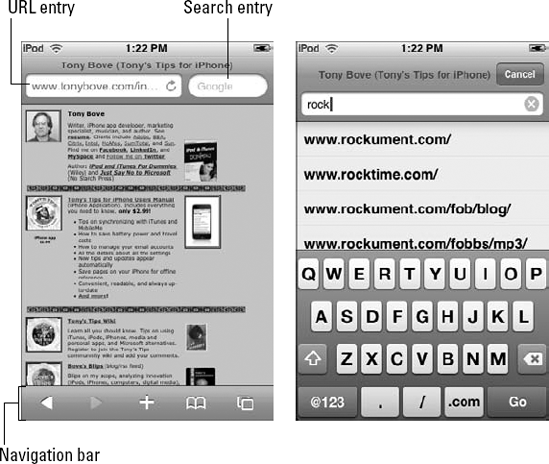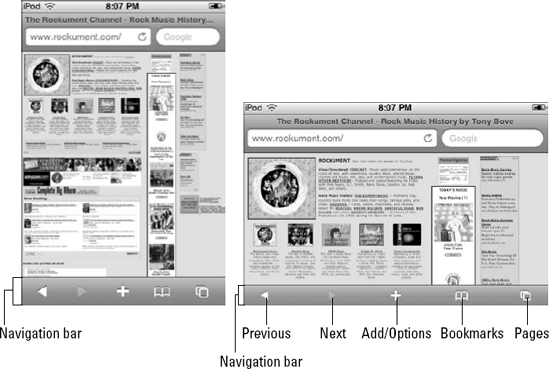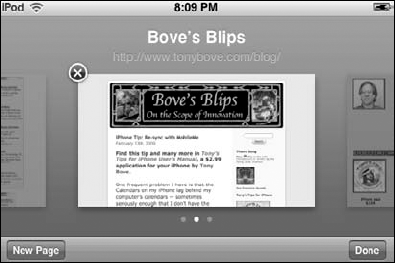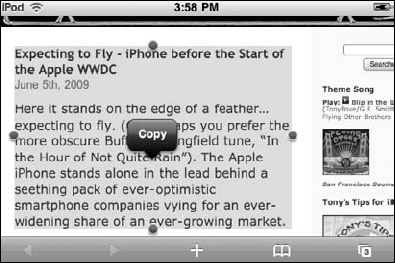Browsing the Web with your iPod touch or iPhone
Navigating, scrolling, and zooming into Web pages
Saving and using Web page bookmarks
Saving Web site icons to your Home screen
The World Wide Web makes the world go 'round a whole lot faster than ever before. I browse the Web for many different kinds of content and services. It's gotten to the point where I now use the Web to make travel, restaurant, and entertainment reservations, and I purchase everything online, from music, videos, books, and clothing to electronics equipment, garden supplies, groceries, and furniture. I get to track my shipments and purchases, review the latest news, check up on the blogs of my friends and associates, read novels, view slide shows and movies posted on the Internet, and even scan text messages from cell phones — all thanks to the Internet.
I can do all this using the Safari browser on an iPod touch or iPhone with an Internet connection, so I rarely need a laptop when I travel. I can also search using Google or Yahoo! — both services are built into Safari, and I can always browse any other search site. An iPod touch or iPhone can join AirPort and other Wi-Fi networks at home, at work, or at Wi-Fi hotspots around the world, as I describe in Chapter 4, to connect to the Internet. An iPhone can also use the Edge network, and an iPhone 3G or iPhone 3GS can also use a 3G network.
Safari on the iPod touch or iPhone not only lets you browse through Web sites, but also lets you add bookmarks and icons to your Home screen for convenient access. (You can also synchronize those bookmarks with your computer's Web browser, as I describe in Chapter 10.)
It's a snap to browse any Web site. Just tap out the site's address on the on-screen keyboard. (For instructions on using the on-screen keyboard, see Chapter 3.)
Note
The Web site address is known as a URL (Uniform Resource Locator) and usually begins with http://www. followed by the name of the Web site or other characters (such as http://www.apple.com or http://www.tonybove.com/tonytips). However, you can leave off the http://www. part and just go with the rest of the characters of the URL (apple.com or tonybove.com/tonytips).
For the blow-by-blow account, check out the following steps:
Tap Safari on the Home screen.
The iPod touch or iPhone displays the last Web page you visited or a blank page, with the rectangular URL entry field at the upper-left corner and an oval search-entry field in the upper-right corner, as shown in Figure 19-1, left side. (If you don't see these two entry fields side by side, tap the status bar at the top of the screen to jump to the top of the Web page.)
Tap the URL field.
The on-screen keyboard appears. Above that is an entry field for typing the URL.
If the entry field already has a URL, tap the circled x in the right corner of the field to clear its contents.
Tap out the URL for the Web page using the on-screen keyboard.
Immediately as you start typing the characters of the URL, you see a list of suggested Web sites in your bookmarks or history list that match the characters you typed so far (as shown in Figure 19-1, right side). You can scroll the suggested list by dragging up and down. If the Web site you want appears, tap it to go directly to the site without further ado. Otherwise, keep typing the URL, including the extension — the keyboard includes a .com button, next to the Go button, for your convenience.
Tap the Go button on the keyboard (or tap Cancel to cancel).
When you tap the Go button, the keyboard closes and the message
Loadingappears in the status bar. Then the Web page loads from the Internet, if the page exists. If you mistyped the URL or the page doesn't exist, you get the messageSafari can't open the page because it can't find the server. Tap OK and start again from Step 2.To cancel entering a URL, tap the Cancel button in the upper-right corner of the screen (refer to Figure 19-1, right side).

Figure 19-1. The URL and search fields (left). Start entering the URL and suggestions appear (right).
Tip
To stop a Web page from loading if you change your mind, tap the x on the right side of the URL entry field. This x turns into a circular arrow after the page is loaded. To reload an already-loaded Web page to refresh its contents, tap the circular arrow.
If you already have bookmarks saved in your iPod touch or iPhone, you can go directly to your favorite bookmarked pages. (To add bookmarks to your iPod touch or iPhone, you can sync bookmarks from your computer's Web browser, as described in Chapter 10, and you can also save bookmarks of pages you visit with your iPod touch or iPhone, as described in the section "Bookmarking as You Go," later in this chapter.)
Follow these steps:
Tap Safari on the Home screen.
Your iPod touch or iPhone displays the last Web page you visited or a blank page. A navigation bar sporting various icons and buttons appears along the bottom, as shown in Figure 19-2.
Tap the Bookmarks icon — the one that looks like an open book — on the navigation bar.
The Bookmarks screen appears with the special History folder that records your page visits, and other Bookmark-related folders (such as Bookmarks Bar and Bookmarks Menu, provided with the Safari application on Macs and PCs). You can scroll this list by dragging up and down.
Tap a folder to view its contents.
For example, tapping Bookmarks Menu opens the folders and bookmarks from the Bookmarks Menu section of Safari on your Mac or PC. Tapping Bookmarks Bar opens the folders and bookmarks in the Bookmarks Bar section. Tapping History opens the history of the Web pages you've visited.
Tap a bookmark to load the Web page.
Folders have a folder icon to the left of their names, and actual bookmarks have an open-page icon next to their Web page names. Tap a folder to reveal its contents, and tap a bookmark to load a Web page.
Tip
As shown in Figure 19-2, you can rotate the iPod touch or iPhone sideways to view Web pages in landscape (horizontal) orientation and then double-tap to zoom in or out — Safari automatically fits sections of Web pages (such as columns of text) to fill the screen for easy reading. You can also spread with two fingers to control the amount of zooming.
If you've done any Web surfing at all, you already know all there is to know about search engines. They're simply the tool for finding Web sites. The two most popular search engines out there — Google and Yahoo! — are built into Safari on your iPod touch or iPhone.
Tip
Google is set up to be your default Web search engine, but you can quickly change that. To choose Yahoo! (or to go back to Google), tap Settings
Follow these steps to search with Google or Yahoo! from within Safari:
Tap Safari on the Home screen.
The last Web page you visited or a blank page appears. You can find the URL entry field in the upper-left corner and the oval search-entry field, with
GoogleorYahoo!in gray, in the upper-right corner (refer to Figure 19-1, left side). (If you don't see these two entry fields side by side, tap the status bar at the top of the screen to jump to the top of the Web page.)Tap the oval search-entry field.
The keyboard appears. Above that is the search-entry field (with a magnifying glass icon).
Tap inside the search-entry field.
Tap out the letters of the search term using the keyboard.
Immediately as you start typing characters, you see a list of suggested bookmarks in your bookmarks folder or history list. You can scroll this list by dragging up and down.
If a bookmark appears that satisfies your search, tap it to go directly to the Web page without further ado. Otherwise, keep typing the search term.
Tap the Google or Yahoo! button at the lower-right corner of the keyboard.
Doing so closes the keyboard and displays the search results. (Note: The Google or Yahoo! button replaces the Go button on the keyboard when searching.)
After you've found the Web page you want, you can use your fingers to navigate its links and play any media it has to offer. You can also bounce around from previous to next pages in your browsing session, open multiple pages, zoom into pages to see them clearly, and scroll around the page to see all its sections while zooming.
To zoom into a Web page in Safari, spread two fingers apart on the screen (unpinch). To zoom back out, bring your fingers together (pinch).
Double-tap the display to zoom into any part of the page. You can also double-tap a column to automatically zoom in so that the column fills the display. Double-tap again to zoom back out.
To scroll around the page, touch and drag the page. (If you happen to touch a link, drag the link so that you don't follow it.) You can drag up, down, or sideways to see the entire Web page, or you can flick your finger up or down to quickly scroll the page. Use two fingers to scroll within the frame on a Web page or one finger to scroll the entire page.
Tip
To jump to the top of a Web page, tap the status bar at the top of the screen.
All of these gestures work the same way in either portrait or landscape orientation. To view a Web page in landscape orientation, rotate the iPod touch or iPhone sideways. Safari automatically reorients and expands the page. To set it back to portrait, rotate it again.
To follow a link on a Web page, tap the link. Text links are usually underlined (sometimes in blue). Many images are also links that you can tap to navigate to another page or use to play media content.
If a link leads to a sound or movie file supported by the iPod touch or iPhone, Safari launches the player for the sound or movie; if the link points to YouTube, the YouTube app launches to play the video. (See Chapter 16 for sounds and Chapter 17 for videos.)
Tip
You can see the link's destination — without following it — by touching and holding down on the link until the destination address appears (next to your finger). You can touch and hold an image to see whether it has a link.
To move to the previous page in your browsing sequence, tap the left-arrow button in the left side of the navigation bar at the bottom of the screen. (Refer to Figure 19-2.) Safari replaces the current page with the previous one. If you've just started browsing and this is the first page you've opened, the left-arrow button is grayed out.
To move to the next page, tap the right-arrow button (to the right of the left-arrow button) in the navigation bar at the bottom of the screen. (Refer to Figure 19-2.) Safari replaces the current page with the next one in the browsing sequence. This button is grayed out unless you've navigated backward to some previous page.
Tip
You can always go back to any of the pages you visited by tapping the Bookmarks button on the navigation bar and then tapping History. To clear your History list on your iPod touch or iPhone, tap Clear.
Although you can open Web pages one at a time and switch back and forth between them, you can also open several pages and start a new browsing sequence with each page, just like opening separate browser windows or tabs.
Some links automatically open a new page instead of replacing the current one, leaving you with multiple pages open. Safari displays the number of open pages inside the Pages icon in the right corner of the navigation bar at the bottom of the screen. If there's no number on the icon, it means only one page is open.
To open a separate page, tap the Pages icon on the right side of the navigation bar at the bottom of the screen; then tap the New Page button. Safari brushes aside the existing page to display a new one. You can then use your bookmarks, enter a Web page URL, or search for a Web page. (If you change your mind and don't want to open a new page, tap the Done button to cancel.)
To close a separate page, tap the Pages icon on the right side of the navigation bar to display the page thumbnail images and then tap the red circled x in the upper-left corner of the Web page thumbnail for the page you want to close. The page disappears.
To switch among open pages, tap the Pages icon to display the page thumbnail images, as shown in Figure 19-3, and flick left or right to scroll the images. When you get to the thumbnail image of the page you want, touch it!
Many Web pages have pop-up menus for making choices. For example, the NextBus Stop Selector site (www.nextmuni.com) offers pop-up menus for selecting the state, the transit agency, and the bus line. To make choices for a pop-up menu, tap the menu. Safari displays a list of possible choices for that pop-up menu (such as a list of bus lines). Choose one by tapping it; you can also flick to scroll the list of choices.
After choosing an option, tap the Done button to finish with that pop-up menu. You can also tap the Previous or Next button to move to the previous or next pop-up menu.
Entering text into a Web site — such as reservation information, passwords, credit card numbers, search terms, and so on — is as easy as tapping inside the text field. Safari brings up the keyboard for typing the text. You may want to rotate the iPod touch or iPhone sideways to view Web pages in landscape (horizontal) orientation so that the keyboard is wider and easier to use.
You can move to the next or previous text field by tapping the Next or Previous button at the top of the keyboard, or by tapping inside another text field. To finish typing with the keyboard, tap the Done button. If you don't like what you typed, use the Backspace key to delete it before tapping Done.
After you finish filling out all the required text fields on the page, tap Go on the keyboard (or tap Search, which some pages use rather than Go). If the Web page is a form, tapping Go automatically submits the form. Some Web pages offer a link for submitting the form, which you must tap to finish entering information.
You may want to copy one or more paragraphs of text from a Web page to paste into another app (such as Notes) or into an e-mail message. Although you can e-mail a link to a Web page (as I show in the section "Sending a Web link by e-mail," later in this chapter), you may want to copy a section of text and then paste the section into the message itself.
To copy a section of text from a Web page, touch and hold somewhere within the section (also known as a "long tap"). Safari automatically highlights the section with selection handles on either end and displays the Copy bubble. (See Figure 19-4.) Tap Copy to copy the selection.
If you zoomed into the Web page and the "long tap" selects only a single word, try zooming out first (pinching) and then trying the "long tap" (touch and hold) again. You can also make a more precise selection by dragging one of the handles. A rectangular magnifier appears for dragging the handle precisely. When you remove your finger to stop dragging, the Copy bubble appears.
For details on pasting the selected text into apps such as Notes or into an e-mail message, see Chapter 3.
The best way to keep track of Web pages you've visited and want to visit again is to create bookmarks for the pages. You can then quickly go back to that page by selecting the bookmark. The bookmarks in your iPod touch or iPhone synchronize with your Safari bookmarks on your Mac, or with your Safari or Internet Explorer bookmarks on your PC, as I describe in Chapter 10.
Follow these steps to save a bookmark:
Browse to the Web page you want.
Tap the plus (+) sign in the middle of the navigation bar (refer to Figure 19-2).
The special options menu appears with the Add Bookmark, Add to Home Screen, Mail Link to This Page, and Cancel buttons.
Tap the Add Bookmark button to add a bookmark.
The name of the Web site appears in the title field, ready for editing, along with the on-screen keyboard. Below that is the actual URL for the Web page, and below that, the Bookmarks folder.
(Optional) Edit the bookmark's title.
Before saving a bookmark, you can edit its title with the on-screen keyboard. Tap the circled x on the right side of the title field to clear its contents, or use the Backspace key on the keyboard to erase backward from the end of the title, and type the new title.
(Optional) Choose a bookmark folder.
Before saving a bookmark, you can choose a bookmark folder for saving it; otherwise, Safari saves the bookmark in the topmost level of bookmarks. Tap Bookmarks to see the list of bookmark folders — you can flick to scroll the list quickly or drag it slowly. Select a bookmark folder by touching it.
Tap the Save button to save the bookmark or tap Cancel to cancel.
The Save button appears in the upper-right corner of the display, and the Cancel button appears in the upper-left corner.
You can also edit your bookmarks and bookmark folders. Tap the Bookmarks button on the navigation bar and choose the folder to edit or the folder that has the bookmark you want to edit. Then tap the Edit button in the lower-left corner of the screen. The Edit Bookmarks display appears, with circled minus (−) signs next to the bookmark folders.
You can then do any of the following:
To make a new folder within the selected folder, tap New Folder. If you want to create a new folder at the topmost level, first tap the Bookmarks button in the upper-left corner to go back to the topmost Bookmarks list, tap the Edit button, and then tap New Folder.
To delete a bookmark or folder, tap next to the bookmark or folder and then tap Delete.
To reposition a bookmark or folder, drag next to the item you want to move.
To edit the name of a bookmark or folder, tap the bookmark or folder and use the on-screen keyboard to type the new title. (Tap the circled x in the title field to clear its contents first, if you want.)
To change where a bookmark or folder is stored, tap the Bookmark Folder field for the selected bookmark or folder and then tap a new folder to hold the folder chosen for editing.
Tap the Done button in the lower-left corner of the Edit Bookmarks display to finish editing.
As I describe in Chapter 20, your iPod touch or iPhone can send e-mail as well as receive it, as long as it's connected to the Internet. And if you want to share a Web page you just found with your friend, the steps are simple:
Browse to the Web page and then tap the plus (+) sign in the middle of the navigation bar at the bottom of the screen. (Refer to Figure 19-2.)
A special options menu magically pops up from the bottom with the Add Bookmark, Add to Home Screen, and Mail Link to This Page buttons, along with a Cancel button.
Tap the Mail Link to This Page button.
Keep in mind that you must have already set up an e-mail account on your iPod touch or iPhone, as I describe in Chapter 10.
An e-mail message appears, ready for you to finish composing. The Subject field is already filled in with the Web page name, and the link itself is already inserted in the body of the message. The To and Cc fields are left blank — ready for you to fill in.
Tap the circled plus (+) sign on the right side of the To field to select a name from your Contacts list, or use the on-screen keyboard to enter the e-mail address.
See Chapter 20 for details on sending an e-mail.
Tap Send at the upper-right corner of the display to send the message.
You can add Web thumbnail icons for your favorite Web pages to the Home screen so that you can access the page with one touch. Web icons appear on the Home screen along with the icons of other apps. (Discover how to rearrange the icons and add multiple screens to the Home screen in Chapter 3.)
Follow these steps to add a Web site to your Home screen:
Browse to the Web page you want.
Tap the plus (+) sign in the middle of the navigation bar.
The special options menu appears, with Add Bookmark, Add to Home Screen, Mail Link to This Page, and Cancel buttons.
Tap the Add to Home Screen button.
The name of the Web site appears in the title field, ready for editing, along with the keyboard. The icon to be added to the Home screen — a thumbnail image of the site or a graphic image defined by the site for this purpose (usually a logo) — appears to the left of the title field.
(Optional) Edit the Web icon's title.
Before saving a Web icon to the Home screen, you can edit its title with the keyboard. Tap the circled x on the right side of the title field to clear its contents, or use the Backspace key on the keyboard to erase backward from the end of the title and then type the new title.
Tap the Add button to add the Web site icon, or tap Cancel to cancel.
The Add button appears in the upper-right corner of the display, and the Cancel button appears in the upper-left corner.



